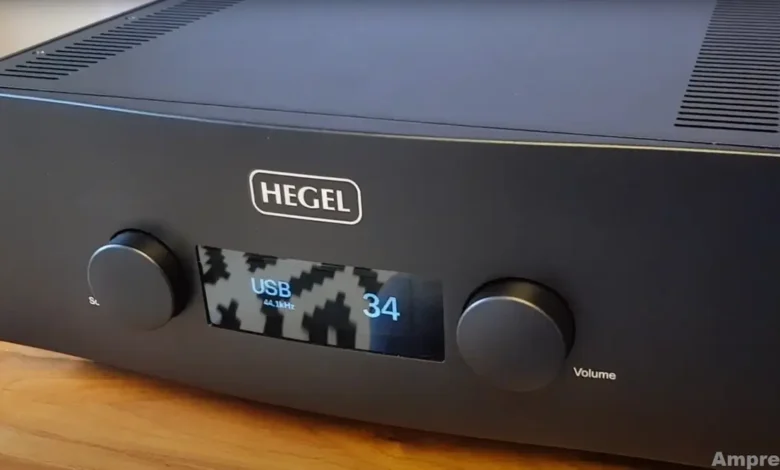

This number in advance: 300. Namely 300 watts. Sine. per channel. And at 8 ohms. The power output of the new Hegel H590 is unusually high and is easily 100 watts more than most of the other “big” integrated amplifiers in this class. With 300 watts at 8 ohms, Hegel’s new flagship amplifier fits seamlessly into the list of “big”, very powerful and extraordinary amps like the McIntosh MA 9000, Gryphon Diablo 300, or ASR Emitter II Exclusive. The Norwegians are already putting a big exclamation mark in this area.
The immense power yield can be attributed to two reasons. On the one hand, those responsible for Hegel actually wanted to develop a superpower amplifier (working name: Big Brother). But over time, more and more requests were added: preamp function, D/A converter, streaming… On the other hand, Hegel boss and mastermind Brent Holter says with a smile: “because we can do it.”
When I was visiting Hegel in Oslo a few weeks ago, I had the opportunity to talk to Bent Holter for half an hour. And of course, I also had to ask this question: “Why does such a sympathetically reserved company as Hegel come with an amplifier in the $10,000 class? Does it have to be that way? Isn’t a powerhouse like the H360 (250 watts/channel) enough?”
“Hm,” said Holter, “we were just ready for the next step. We have so many new technologies… But we also had to do something new because, for example, the H30 vintage Toshiba transistors we used before are hard to come by.”
Between the lines, one could also hear that those responsible at GP Acoustics (KEF), the German Hegel distributor, expressly wanted an amplifier that could also confidently drive the technically demanding sound sculptures KEF Blade and KEF Blade II. Because there are not that many of them on the world market…
Now there’s one more: I’ve been able to listen to the combination of Hegel H590 and Blade for many hours – this wish of the GPA people was fulfilled in a very convincing way.
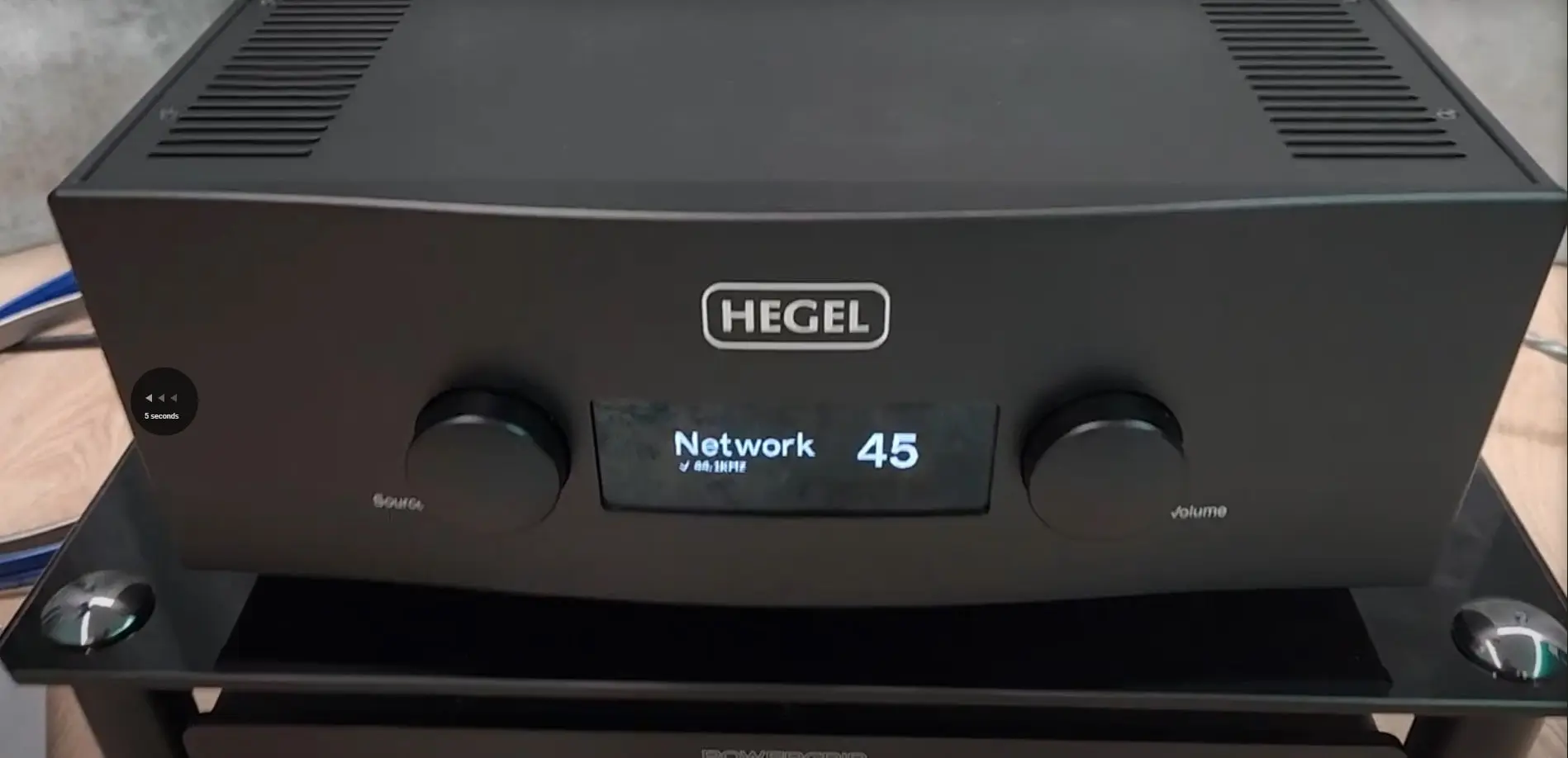

Hegel H590 Comes With Advanced Technology
A few keywords have to be mentioned when describing the Hegel H590. The most important: is the SoundEngine. Holter dreamed up the SoundEngine while still working for the Norwegian oil industry. You also need highly sensitive circuits there. He adapted his experience to audio and the result was the SoundEngine, a module that significantly reduces the crossover distortion of classic AB amplifier types (or transistors switched in push-pull mode) at zero crossing. That’s why the Hegel amplifiers always sound so effortless. This circuit is patented and an integral part of the Hegel DNA.
The SoundEngine is now in the second generation, which has been improved once again. It was originally developed for the H360, but is now of course built into all current integrated amplifiers. According to Holter, the SE2 is much “faster” and reduces dynamic distortion by almost 75% compared to the original SE1. Another advantage of the SE2, according to Holter, is its higher damping factor – important for bass control. The H590 uses the best implementation of the SE2 to date and has a damping factor of more than 4000. This number is impressive, however.
And so the physical differences between the Hegel H590 and the previous top amp, the H360, are quite clear. On the one hand, the new flagship is 5 centimeters higher – the heat sink simply had to be much larger. But otherwise, there is almost no more space in the raised housing – as a look under the hood shows. The H590 has a larger transformer, a 50% larger power supply and 12 instead of 8 output transistors per channel.
The Hegel H590 is almost entirely dual-mono: the left and right channels are strictly separated. Only the transformer, which is wound like a toroid, has two taps for the two channels. And the complex digital board as well as the preamp have their own power supply anyway. Nothing should influence each other…
The case mechanics of the large Hegel integrated amplifier are similar to those of his smaller amplifiers: they are very neat. And yet, says Holter, the housing of the H590 is better in terms of sound than that of its smaller siblings. Steel parts in the top and bottom plates proved to be magnetic interferers. By removing them, previously inexplicable distortions disappeared. That’s always my plea to all hi-fi manufacturers: pay more attention to the housing – unfortunately they are more important for the sound than we would like…
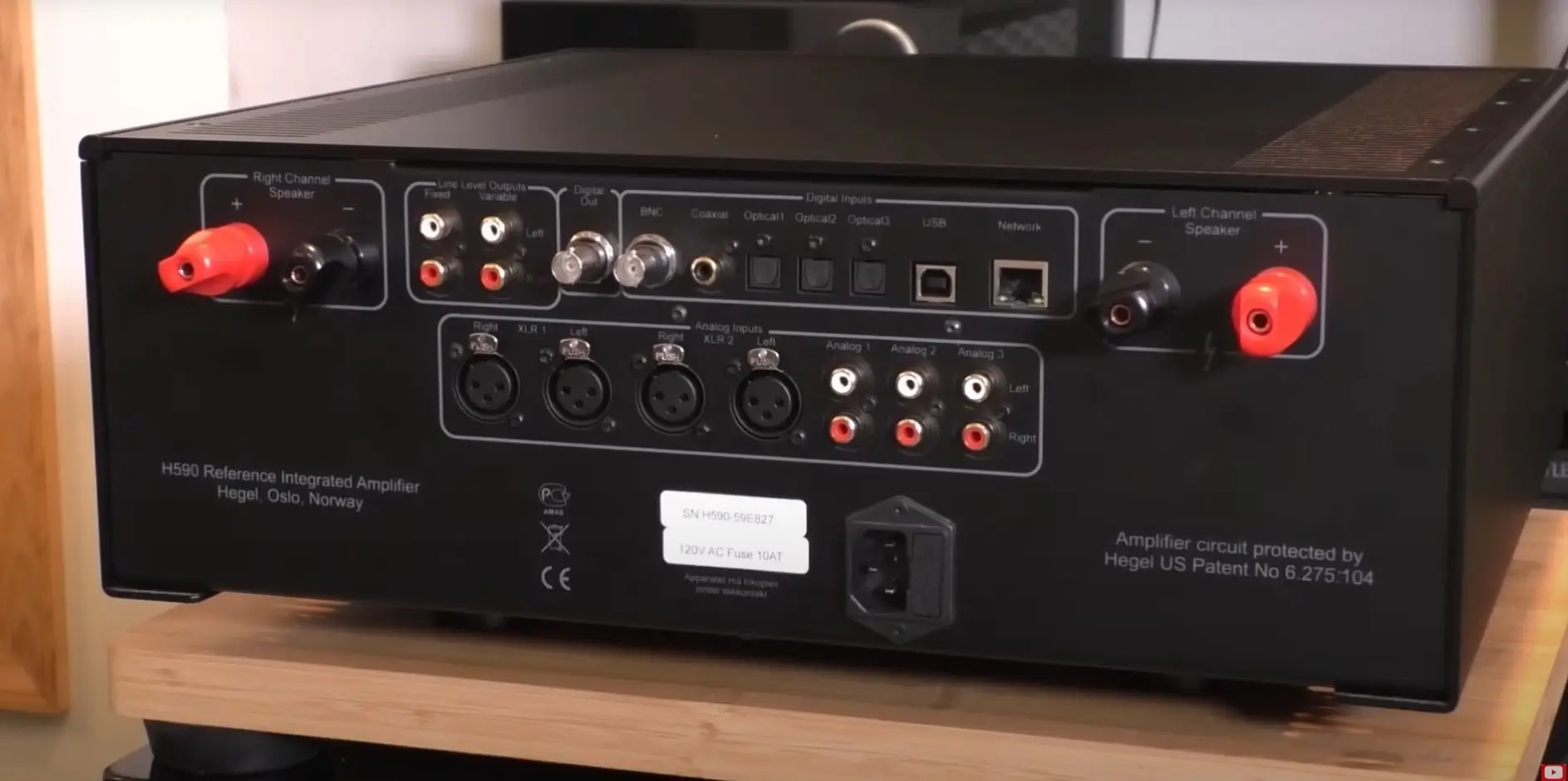

The connection possibilities of the Hegel H590
In addition to the performance stage, the internal DA converter is an essential component of the Hegel H590. One might have guessed that the Norwegians would simply place the digital board of their top converter HD30 in their flagship amplifier. nothing there If you talk to the Hegelians, they admit quite frankly that they like the sound of the DAC from their Mohican CD player better. They explain the advantage of the Mohican DAC as treating all sampling frequencies in their native form. In short: Hegel is no friend of internal upsampling.
The same goes for Bluetooth. When I asked why this amplifier, which is top-of-the-line in almost every respect, doesn’t also have Bluetooth, I got astonished looks. “No, no,” said Bent Holter. “With Bluetooth, you get serious audio problems. That’s why we leave BT outside when it comes to high-end components.”
But Hegel has developed a completely new USB interface for the H590. This should not only sound better but also give the user access to formats such as MQA or other high-resolution formats such as DSD256 or 23/384 PCM.
Another keyword: MQA. There is an idiosyncratic discussion going on about MQA. Whether this way of packaging is appropriate and whether the whole thing is HiRes.
Bent Holter feels the same way. Holter: “We are very impressed with the MQA sound. In the Hegel H590, MQA has its signal path in the amplifier and will not interfere with PCM.”
And while I’m still sitting at my desk trying to visualize the equipment list of the Hegel amp again, an email from Hegel Sales GPA flutters into my inbox: “Very up-to-date: With the latest update, the H590 is also Roon-ready and understands Audirvana++”. Yes, what else can this integrated amplifier do? For example, sounding good.
Hegel H590 Sound Test
I had the opportunity to hear the H360 vs. the H590 during my Hegel visit to Oslo. The difference in favor of the new flagship was bigger than I thought. Above all, it is this stability, the sovereignty from below.
You can feel the power of the 300 watts: “301 watts if you please, that’s enough time,” Bent Holt would now object mischievously. Because all measurements in the Hegel laboratory always determined more than 300 watts. That’s important to him. At 4 ohms it is almost 600 and at 2 ohms (which the Hegel H590 can tolerate) almost 1,000 watts per channel. Even impedance-critical and very quiet sound transducers should be able to be operated with it.
The Triangle Esprit Australe EZ is such a case. The impedance of the three 18 cm woofers often falls below 3 ohms in the performance-relevant range around 100 Hertz. If you then listen loud, many power amplifiers switch off as a precaution.
Not so the Hegel H590. Even with such extremely energetic music as by the indie/psychedelic band Infected Mushrooms. I have no idea how the Israelis manage to get so many amplifiers to die so quickly with their music. But it’s a fact.
A nice example: is the brilliant album Converting Vegetarians, titled “Apogiffa Night”: The electronic beats come with so much blackness, power & boom that it’s a joy – especially when you listen to this music very, very loud.
The phalanx of comparison amplifiers I brought up ( Cambridge Audio Edge A, McIntosh MA 7900 AC, Pass INT-60, T+A PA 2500 R ) performed better on the triangle ( McIntosh, T+A ) and less ( Pass ) brave. But only the H590 played so loud and undistorted, so structured from below.
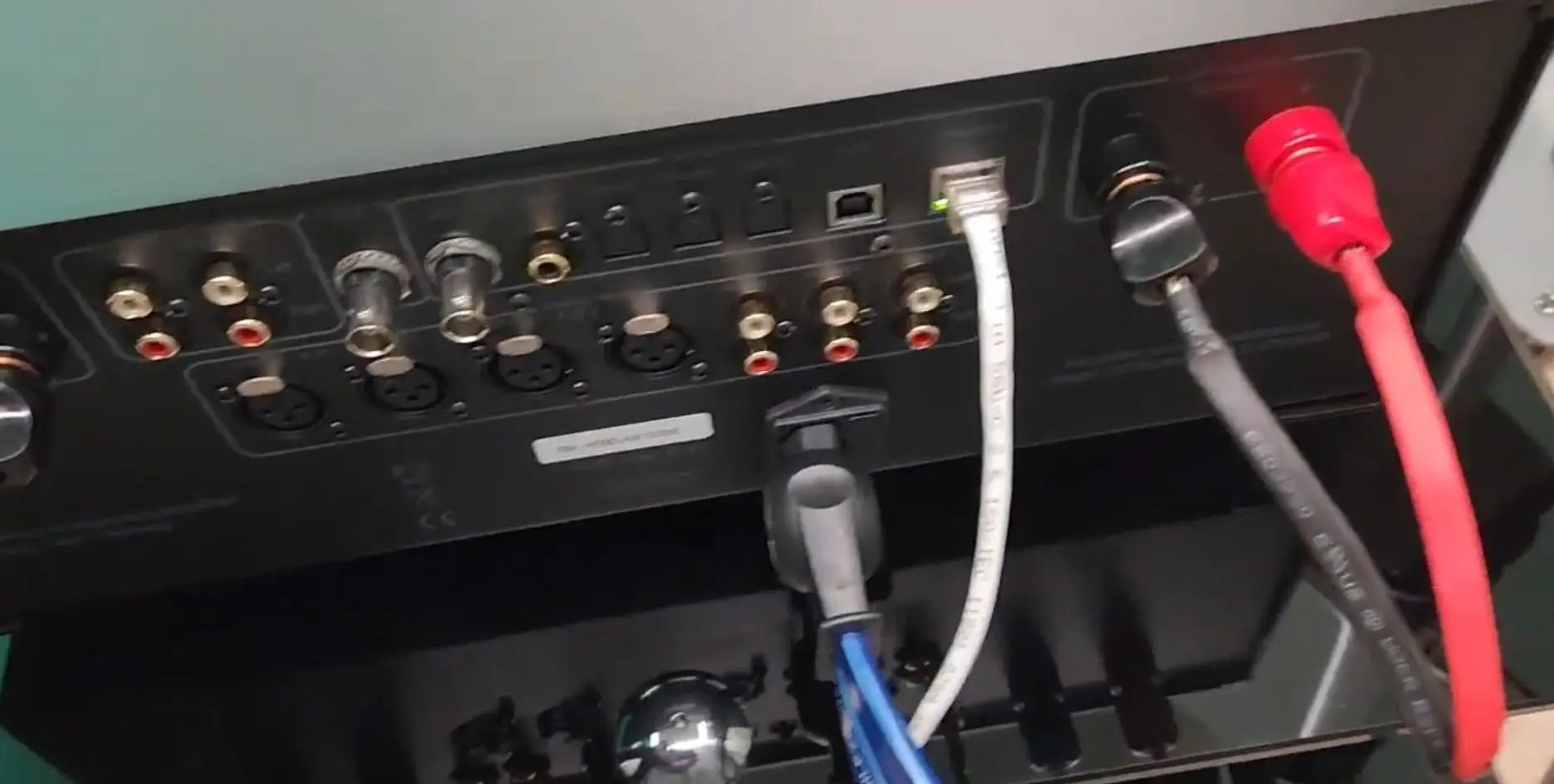

The differences in the amplifiers were evident on all three loudspeakers, which of course all have their characteristics. Each of these integrated amplifiers is something special.
The T+A plays extremely agile and powerful, also nice and dry in the bass, but not quite as resolving and natural as the Hegel. The McIntosh is a laid-back amp that packs a punch to handle any type of music on any speaker.
In terms of the sheer development of power, he came closest to Hegel – but without achieving his lightness and openness. The Cambridge plays wonderfully nimble, balanced, and fine. However, in the end, it didn’t even come close to the outstanding naturalness and calmness of the H590 – also because it lags in terms of performance.
But let’s separate ourselves from the performance analysis: With the extremely lively and authentic tango music by the Italian Alessandro Quarta, the H590 is certainly not the most spectacular. Nevertheless, even with such music, his mixture of naturalness, impulsive power, and calm precision seems a bit more authentic than most of his competitors.
Does the Pass Hegel H590 sound better than other amps on the reference shelf? None of the other integrated amplifiers match the sheer beauty, accuracy, and breathtaking finesse of the Hegel H590—not even the INT60. However, the Hegel’s robust power output far surpasses the 30 or 60 watts of the Class A Pass amplifier, making it better suited for delivering high volume levels in a large 70 square meter listening room with most speakers. The dynamic, full-bodied sound that brings recordings from artists like Infected Mushroom and Yello to life is far more achievable with the Hegel H590.
Conclusion
Measured by the number sold, there is an astonishing number of amplifiers in the hi-fi market for around 10,000 euros or even more. It may be that many of them have a right to exist, but I can hardly believe it. The case is different with the Hegel H590: This streaming integrated amplifier made a lasting impression on me.
On the one hand, it has so many options for playing a wide variety of sources and formats that it’s difficult to list them all… on the other hand, it’s one of the most powerful integrated amplifiers I’ve come across so far; Impedance-critical and/or very quiet loudspeakers are given a drive that can hardly be more sovereign.
Sure: you can get performance and stability from stage power amplifiers for less money. But this H590 also sounds so breathtakingly calm and natural that it may not outclass the best of its kind, but keeps it at a distance.
If you are not fixated on the top dogs from Accuphase or McIntosh, the Hegel H590 offers a highly musical, extremely versatile, and promising alternative.
Hegel H590 Integrated Amplifier FAQs
Q1: What is the Hegel H590?
A: The Hegel H590 is a high-end integrated amplifier with a built-in DAC, designed to offer world-class sound quality and power. It combines analog amplification with digital conversion, making it versatile for various audio setups.
Q2: What is the power output of the Hegel H590?
A: The amplifier delivers 301 watts per channel into 8 ohms, providing substantial power to drive even the most demanding speakers with ease.
Q3: What kind of DAC does the H590 use?
A: The H590 features a high-quality, state-of-the-art DAC that supports high-resolution audio up to 32-bit/384kHz for PCM and DSD256, offering excellent digital audio conversion.
Q4: What inputs are available on the Hegel H590?
A: The amplifier offers a variety of inputs, including analog inputs (balanced XLR and unbalanced RCA), digital inputs (coaxial, optical, USB, and network streaming), and a USB-B input for computer audio.
Q5: Does the H590 support streaming services?
A: Yes, the Hegel H590 supports streaming via UPnP, Apple AirPlay, and Spotify Connect. It is also Roon Ready, providing convenient integration with high-quality music streaming services.
Q6: Can I use the H590 as a preamplifier?
A: Yes, the H590 has preamp outputs, allowing it to function as a preamplifier if you choose to add a separate power amplifier in the future.
Q7: Is there a built-in phono stage for vinyl playback?
A: No, the H590 does not come with a built-in phono stage. An external phono preamp is required to connect a turntable.
Q8: Does it come with a remote control?
A: Yes, the H590 includes a remote control, allowing for convenient control of volume, input selection, and playback.
Q9: What is SoundEngine 2 technology?
A: Hegel’s SoundEngine 2 technology is a proprietary distortion-reducing circuit that corrects signal errors in real-time, resulting in a cleaner and more detailed sound.
Q10: How can I update the firmware of the Hegel H590?
A: Firmware updates for the H590 can be performed via USB or through the network connection, ensuring the amplifier stays current with software enhancements.
Pros and Cons of the Hegel H590 Integrated Amplifier
Pros:
Great Sound Quality
Power Output
Excellent Built-In DAC
Versatile Connectivity
Proprietary SoundEngine 2 Technology
Streaming Capabilities
Preamp Outputs:
Solid Build Quality
Cons:
Bit Expensive
No Built-In Phono Stage
a little bit Heavy
Limited Streaming Features Compared to Some Competitors
Hegel H590 Manual
The Complete User Manual for Hegel H590 here


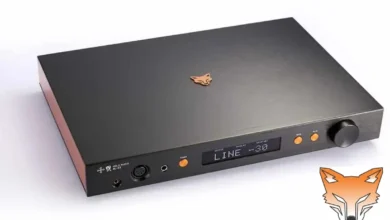
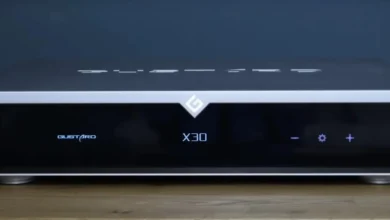

GIPHY App Key not set. Please check settings